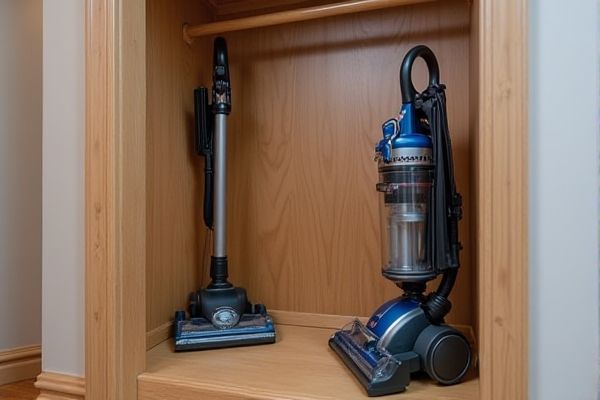
Closet vacuums offer compact storage solutions, fitting easily into small spaces without sacrificing powerful cleaning performance, while upright vacuums typically require more room but provide greater versatility for deep-cleaning large areas. Discover which option best suits Your storage needs and cleaning habits by exploring the full comparison in this article.
Table of Comparison
| Feature | Closet Vacuum | Upright Vacuum (Storage in Closet) |
|---|---|---|
| Storage Space | Compact, fits easily in small closets | Requires larger closet space due to height and bulk |
| Portability | Lightweight and easy to carry | Heavier, less portable |
| Ease of Storage | Designed for tight closet spaces, often with wall mounts | Needs more floor area; difficult in cramped closets |
| Cleaning Efficiency | Effective for stairs, corners, and small areas | Powerful for large floors and carpets |
| Accessibility | Quick access due to smaller size | Bulkier, sometimes inconvenient to remove from closet |
| Price Range | Generally lower to mid-range pricing | Mid to high-range pricing |
Introduction: Closet Vacuum vs Upright Vacuum for Closet Storage
Closet vacuums, typically compact and lightweight, offer superior storage convenience for small spaces compared to bulkier upright vacuums. Their slim design and detachable components allow easy placement in narrow closets without compromising accessibility. Upright vacuums, while powerful and effective for deep cleaning, often require more storage room and may limit space efficiency in closet organization.
Space Efficiency: Compactness and Footprint
Closet vacuums are designed with compactness in mind, often featuring a smaller footprint that fits easily into tight storage spaces without cluttering the area. Upright vacuums, while generally larger, can be space-efficient if stored vertically against a wall or inside a closet with sufficient height clearance. Choosing a vacuum with a slim profile and detachable components enhances space efficiency, making closet storage more manageable.
Ease of Storage: Handling and Maneuverability
Closet vacuums excel in ease of storage with their compact, lightweight designs allowing for quick placement in small spaces, making them ideal for tight closets. Upright vacuums often have bulkier frames but benefit from integrated cord wraps and ergonomic handles that aid maneuverability during use. Closet vacuums typically offer superior maneuverability due to their swivel heads and compact build, while uprights provide powerful suction with more effort required for navigation in confined areas.
Design Features: Foldability and Accessories
Closet vacuums excel with foldable designs that save space, allowing easy storage in tight closets without bulky parts. Upright vacuums often include a variety of accessories like crevice tools and brushes that enhance cleaning versatility but may require additional storage room. Choosing a closet vacuum ensures your storage area remains organized, while upright models offer comprehensive cleaning options for different surfaces.
Suitability for Small Closets
Closet vacuums are ideal for small closets due to their compact size and slim design, allowing for easy storage without occupying much space. Upright vacuums, while powerful, tend to be bulkier and require more clearance, making them less suitable for tight storage areas. If your priority is maximizing storage efficiency in a small closet, choosing a closet vacuum will better accommodate your space constraints.
Weight and Portability Comparison
Closet vacuums are typically lighter and more compact, making them easier to carry and store in small spaces compared to upright vacuums, which tend to be bulkier and heavier due to their larger motors and dust bins. The average closet vacuum weighs around 5-10 pounds, enhancing maneuverability for quick cleanups, while upright vacuums usually range from 12-18 pounds, favoring powerful suction but reduced portability. For users prioritizing storage efficiency and ease of use, closet vacuums provide a significant advantage in weight and portability over traditional upright models.
Setup and Accessibility in Closets
Closet vacuums, designed with compact dimensions and lightweight construction, streamline setup and enhance accessibility within tight storage spaces. Upright vacuums, though bulkier, often feature detachable components that can be stored separately to optimize closet space. Efficient organization of cords and accessories further improves convenience and readiness for use in both vacuum types.
Maintenance Needs in Storage Spaces
Closet vacuum cleaners typically require less maintenance due to their compact design and fewer moving parts, making them ideal for tight storage spaces where ease of access is crucial. Upright vacuums, while often more powerful, may demand more regular upkeep such as belt replacements and brush roll cleaning, which can be challenging if your storage space is limited. Choosing the right vacuum for your closet storage depends on balancing maintenance convenience with cleaning performance to suit your specific needs.
Noise Levels and Closet Placement
Closet vacuums typically produce lower noise levels compared to upright vacuums, making them ideal for storage in small, enclosed spaces where minimizing sound disturbance is important. Their compact design allows for easy placement in closets without sacrificing maneuverability or storage efficiency. Upright vacuums, while generally louder, require more closet space and are less suited for tight storage areas due to their bulkier size.
Final Recommendations for Closet-Friendly Vacuums
For closet-friendly vacuums, compact canister models and slim upright vacuums offer optimal storage efficiency without sacrificing suction power. Consider lightweight designs with detachable parts or foldable handles to maximize limited closet space. Cordless vacuums with wall-mount options also provide convenient, space-saving storage solutions ideal for small closets.
 homyna.com
homyna.com